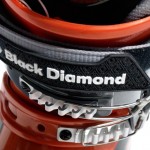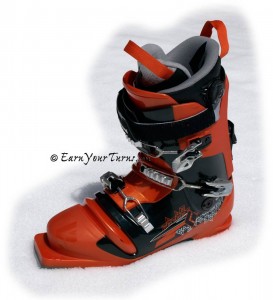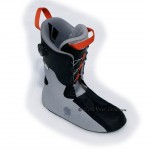For Black Diamond, the Seeker is the most touring friendly telemark boot in their line. It is not, an unfriendly touring boot, but it is more of a small big boot, than a big small boot. By that I mean it is optimized more for turning than for the earning. So while it certainly is the most touring friendly of BD’s tele boot line, if your emphasis is for touring this boot is a bit oversized, particularly on long tours.
It packs a lot of power for downhill control thanks to the extra muscle provided by the BOA lacing system on the liner. There’s a lot of overlapping layers of plastic on the cuff too, further adding to the muscle of this boot.Some folks will automatically discount the power of this boot because it only has one buckle on the cuff. In most situations I’m inclined to view a fourth buckle as a mental crutch, but that’s because I don’t venture into the realm that requires it much either. Regardless, the Seeker delivers more than enough power to drive skis with a stocky 100mm plus waist width, even obese planks if you’re under the lifts. Backcountrywise I can’t imagine why anyone would pair these boots with anything wider than 110mm underfoot, but again, that’s the bias of an old leatherneck.
There are several noticeable but not dramatic revisions to this boot. The original Seeker suffered from an imbalance between the flex of the cuff and the bellows. In short, the cuff felt too stiff for the bellows. This revised Seeker for 2011 still packs a lot of wallop from the cuff, but it is a smoother, more balanced flex between the top and bottom of the boot.
The BOA Liner
A good chunk of this comes from changing the routing of the BOA laces across the tongue of the liner. In the original Seeker the laces were held to a specific location as they crossed the tongue of the liner. Now the laces run under a patch which lets the laces move up or down the tongue a little, which allows the tongue to move with your shin as you drive your knee forward. It is a noticeable improvement, but does not completely eliminate the cuff dominant nature of BD’s telemark boot line, even in this, the smallest model. In comparing to other boots in the 3-buckle genre, the Seeker does not pivot as easily around the ankle. That’s a good thing for driving big skis at speed, but a limitation if you want more mobility.I’m still not a big fan of the BOA system. Too much gadgetry and even though they have loosened the grip of the laces on the lower leg they still hold it much tighter than any other liner, or small big boot cuff on the market. The other problem I have with the BOA system is that it tightens the laces from the top. It would be better if they tightened progressively from the bottom.
The Fit
On the plus side, these boots fit well enough to determine overall performance without having to make custom fit modifications. If I were planning to use them long term I would probably downsize to the next shell, add some padding above the instep, swap in a custom footbed, and heat mold ’em. BD did their homework in developing their boot line so for a lot of folks, custom fitting won’t be necessary.
Touring Performance
It should be pointed out that, while these are on the big side of smaller touring boots, they tour well for their size. The flex of the cuff to the rear when in walk mode was enough to allow my front leg to rock back a bit for a longer stride than, say BD’s Custom. My T2Xs allow my leg to bend back further and easier, but these were at least equal or better than Garmont’s Kenai. However, the Seeker’s are clearly the heaviest of the three, weighing 4 lbs. 6 oz. per boot. Ugh!
Buckles

The hooks make adjusting cable position frustrating, don't always hold when loose. Garmont's method is better.
Though I didn’t bother, you can also adjust the forward lean a few degrees, or the cant by loosening and rotating the asymmetrical ankle bolt.
Summary
The most annoying feature of the boot, however, is an oversized duckbill. The spec calls for an 18mm thick duckbill plus or minus 1mm. This particular pair were on the fat side of that spec and I had a very hard time getting them to fit under the toe bale of an O1 and a Switchback. Hammerhead provides a full 22mm of clearance so they fit easily in those bindings but it was odd for them to have trouble wedging into two of the more popular telemark bindings on the market, especially BD’s own O1.
Who is the Seeker for? With three buckles it’s too small of a boot for the aggro downhill turn burner, and the cuff is so substantial it isn’t that efficient on the earning side of the equation either. It is not a good match for this writer but for aggressive skiers who are willing to flirt with the less is more perspective, the Seeker would be a good stepping stone to a smaller boot requiring more finesse with less material. It delivers the power of a bigger boot, while shaving weight and bulk, without fully embracing the light is right paradigm. A good match with fat skis on big days where saving a few ounces on the boot means more vert and thus, more turns.
Black Diamond
Seeker
Weight (Mondo size 27): 4 lbs, 6 oz. (1980 g) per boot,
Size range (mondo): 24 – 30.5
MSRP: $ 639
© 2011



5 comments
1 ping
Skip to comment form
Almost 4 kg a pair! For a three buckle, touring-oriented boot that is waaay too heavy in my view. When Dynafit is producing a boot at a smidgen over 2 kg, with apparently superb control of big skis, you get the sense that maybe BD is not putting all their effort into the tele side of the business. After all, their Prime AT boot with three buckles are, I believe, 3.2 kg.
I can’t get over how capable my last generation T3’s are at 2.6 kg – I’m just glad I bought them before they were discontinued 🙂
I agree with Nick. I don’t know what is in the heads of the tele boot manufacturers. Looking at where everything was going I broke down and bought a pair of used f3s and dynafit TLTs bindings and haven’t looked back. I miss the turn a bit, but can’t imagine putting that much weight on the feet again. I would sooner make a tele boot out of carbon fiber than buy the pigs the industry is sending our way…. heavy boots….heavy NTN….
Tele skiing deserves better.
I thought the Garmont Kenai was comparable to the T3’s and most AT boots in weight. It was slightly better than the T-3 in performance and comfort after a full season doing most of the lines I have always done and other lines I had never done.
Bindings are the big weight thing, not boots in regards to tele vs AT politics. I have no problem sticking with telemarking regardless of some minor technological inconveniences.
I’d been on Garmot EnerG since 2004 and decided it was finally time for a new tele boot. I went through a few G-Fit liners, but overall, the Garmots were a dream, skiing and touring well, and holding up durably for many seasons of heavy use.
I ordered the new Voodoos and was disappointed to find the boot was too narrow. My next choice was the BD Seeker; I had demoed the Push and liked it but didn’t feel I needed the extra stiffness or weight. The Seeker is very similar in dimensions and construction to the EnerG; holding the shells up to each other one could imagine BD may have bought the old Garmot design.
I had the BOA liners heat molded and took them out on the hill. I found the bellows flex similar to the EnerG with a much stiffer cuff and lateral flex; this was the kind of performance I was looking for. The liner didn’t fit perfect; my heel was loose and my toes tight to the end; they were cold, as it seemed the mid buckle cuts off circulation to the toes. They are heavier than the old EnerGs, but overall I liked how they skied and figured they’d be a good boot for me if I could tweak the liners as they broke in.
I toured 3 times and skied the resort twice, then they failed. Taking them off, the BOA lace cord (they’ve replaced the hardwire with what looks like dental floss) wouldn’t release – I was stuck in the liner! I worked the dial mechanism for all it was worth trying to free up the laces with no luck; the dial eventually broke off the liner and the wound-up lace spilled down onto the floor.
Of course BD was willing to replace the boots right away, but I have decided to replace the BOA liners with Intuition.
Author
It sounds like the shop that helped you mold and fit the liners needs a lesson or two on optimizing the fit. If the boot feels too short after molding then the molding process was done wrong.
Did they use toe-caps on your foot when molding? This is standard procedure in my experience to give lots of wiggle room for your toes.
Bottom line, good call on switching to Intuition liners. I think you’ll be happier.
[…] Related Posts Review: Factor MX Review: BD Seeker […]